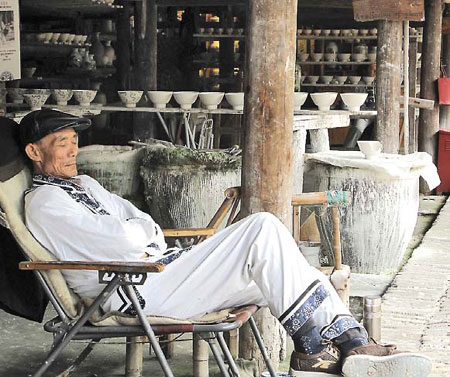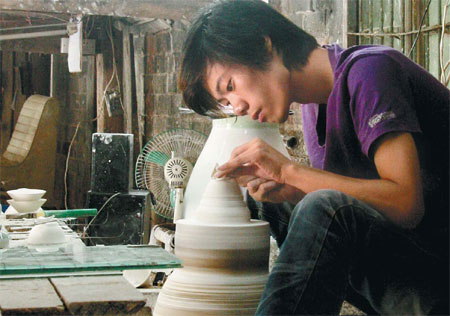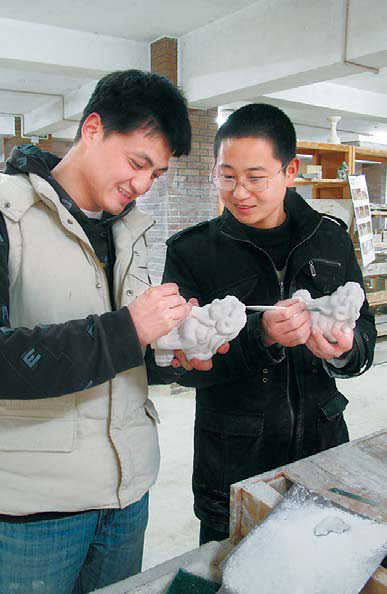'Porcelain capital' hopes to rekindle age of beauty
Updated: 2012-04-10 08:01
By Yang Wanli (China Daily)
|
||||||||
|
A craftsman manages to take advantage of a lull in business last month at a porcelain shop in Jingdezhen, East China's Jiangxi province. [Yang Wanli / China Daily] |
Technique and craftwork kept alive by masters of the delicate art, reports Yang Wanli in Jingdezhen.
In a small town in China, almost all the visitors departing from the local airport attempt to carry the maximum number of suitcases allowed onto the plane.
On the evening of March 22, the flight to Beijing was delayed 15 minutes as the cabin crew rearranged luggage. "It's unbelievable that the rack is full, 20 percent of the seats weren't sold," murmured a stewardess.
When the plane finally took off, the empty seats were occupied by boxes filled with Chinese porcelain.
Jingdezhen, in northeastern Jiangxi province, is a city that has been supported by a single industry for more than 1,000 years. It has been called "The Capital of Porcelain" since an 11th century emperor gave it the name in admiration of its beautiful craftsmanship.
In the following centuries, Chinese vases, bowls and tableware became so famous worldwide that the word "china" became the English word for the material, supplanting the Franco-Italian term "porcelain".
However, that glory has faded over the centuries and now China's leading position in the industry is threatened by goods made overseas.
According to statistics from the China Ceramics Industry Association, the average export price of one piece of Chinese porcelain was just 35 US cents in 2010, just 10 percent of the price of an imported piece. Moreover, the manufacture of porcelain for use in the construction industry has also declined.
Driving around the city, a taxi driver named Li advised his passenger, who claimed to know nothing about ceramics, on how to obtain goods at the lowest possible price. "The market here has some hidden rules that mean a nonprofessional purchaser can easily end up being cheated, especially in terms of "art porcelain", such as ancient bottles and bowls. There is only one way to find a satisfactory deal - haggle. Don't be afraid, you can get some unbelievable prices," he said.
"Porcelain made in Germany, the UK and Japan have great reputations in the international market. But ours are simply viewed as low-end products," said Li Youyu, a master of porcelain production. "The traditional handicrafts haven't been protected well and our designs also lagged behind. It is shameful that 70 percent of the porcelain in the world is made in China, but we have no famous brand. Even worse, our products are sold at the lowest prices."
At the famous Tendence Lifestyle trade show, held annually in Germany, Chinese-made porcelain has attracted a low price in recent years and in most cases, the Chinese exhibitors return home without having secured any orders.
White like jade
Unlike jade ornaments, made from precious stone, and carrying an intrinsic value, porcelain is valued not for the cost of the raw materials, but for the craftwork on display. Over the years, Jingdezhen porcelain has developed four special characteristics: It's white like jade, as bright as a mirror, as thin as paper and it chimes when struck softly.
Today, however, Jingdezhen's porcelain has a reputation for poor quality. The city's 4,000 individual workshops produce identikit goods of varying quality. Some inferior wares, branded "Made in Jingdezhen", have been sold at extortionate prices overseas, but that has sometimes resulted in countries refusing to grant entry visas to the city's merchants to discourage such trade.
The city's porcelain industry failed to develop after the Qing Dynasty and went into almost terminal decline in the 1990s, when its 10 State-owned factories closed during the national enterprise reforms, resulting in tens of thousands of artisans losing their jobs. A handful opened workshops, but most went out of business because the scale of production was so small. Without the continued practice, their skills were lost.
Wang Yansheng, a 76-year-old artisan who specializes in making bases, is one of the workers who experienced those changes. Wang represents the fifth generation of his family to be engaged in the industry, having started work at the Jianguo Porcelain Factory, the country's first State-owned porcelain factory, at age 16.
"The factory developed out of the old imperial kilns. When it opened in 1952, it was the city's largest porcelain works. Workers there were admired because they earned nearly twice the average wage of other industries. The porcelain we made was presented as gifts to foreign leaders at the time," recalled Wang proudly.
A lack of creativity, allied to a poor competitive edge, resulted in the factory going bankrupt in the late 1990s, with only one of every 10 workers remaining in the industry. "But a private workshop is a hard place to make a profit, because of the small scale of production. Most of the workers eventually turned to other jobs, and their skills simply weren't passed on," he said.
Wang took a job at the Ancient Kiln Customs Museum, showing visitors how to make clay into bases, usually for bowls. He earns about 2,000 yuan ($317) a month, roughly as much as the average middle-school teacher.
Like Wang, 10 or more other highly experienced artisans also make a living working at the museum, repeatedly demonstrating a single step in the production process to visitors. Their skills are now simply for show, rather being part of the delicate process of creating high-quality ceramics.
The skills involved in the production of porcelain are traditionally handed on through the master-apprentice system, but Wang has only three apprentices. His 15-year-old grandson is the youngest, but he spends most of his time in school rather than perfecting his skills.
Unlike European craftsmen, who used the same basic set of ingredients but added variations in terms of colors and shapes, most Chinese artisans make their wares using a closely guarded recipe, usually passed down through generations of the same family. Although Wang realizes that a lack of interested young people will mean his skills will eventually die, he is adamant that he will continue with the master-apprentice system.
Essence of tradition
"It's impossible for us to learn the essence of traditional porcelain-making from those masters. We can only start from the very beginning, which may take 10 years or even longer," said Lei Jie, who graduated from Jiangxi Ceramic and Art Institute in 2007.
Lei loves making porcelain and is among the few students in his class still employing the skills they learned in college. He has a workshop in Jingdezhen, where he produces his wares, mostly teapots and cups. However, it's not a profitable way of life and his income barely manages to support his family of three.
Students also bring vitality to the old city. Every Saturday morning, a market for original wares attracts hundred of young artisans. Mostly students from Jingdezhen Ceramic Institute, they bring porcelain and ceramic works which they hope to sell.
Gao Ling, a 23-year-old senior student at the institute, has a workshop near the school. In February, he received an order to make 800 bottles for a perfume company. He said most of his classmates rent apartments nearby the school to use as workshops and almost all have their own business.
Some companies will seek out works that attract them and later place orders. "We can not compete with those old experienced artisans. Our products are not high quality, but we have new ideas," said Gao, with a confident look.
Last year, he brought a motorbike to ease travel between the school and his workshop. He also cooperated with other students who made necklaces and bracelets out of porcelain. "I knew a schoolmate who earned tens of thousands of yuan a year through his workshop business. It's a good start for young people. We can't compete with the older artisans in terms of experience, only in terms of creativity," he said.
"Modern Chinese porcelain simply doesn't enjoy the same reputation it had in ancient times. The competition among workshops now isn't about quality, it's just about lowering costs," Lei said. "It is hard to find excellent wares, let alone masterpieces, in the market."
"To make porcelain by hand allows you to feel the spiritual power inside. People now care more about how something looks than the culture behind it," said Wang Hao, a graduate of the China Academy of Art, who often shares his ideas on shapes and colors with Lei.
"Students can hardly feel the miracles hidden within the process, such as the colors, which really add an element of creativity to the products," he said.
His girlfriend has been working with him for about five years, but they are unable to buy an apartment in the downtown area, which are priced at about 2,000 yuan per square meter.
"I don't know how long I will persist, but hopefully it won't be a short period. I love it and I believe that the industry will improve in future and the city will become a really great place that will give birth to beautiful porcelain, just as it did in ancient times," he said.
Contact the reporter at yangwanli@chinadaily.com.cn
|
A man makes a cup at a ceramics workshop in Jingdezhen, Jiangxi province. Known as China's "Capital of Porcelain", the city is now struggling to recapture its former glory. [Wang Hao / China Daily] |
|
Gao Ling (left) discusses his new work with classmate Chen Wei. Gao, who has a small workshop in the city, is confident about his creativity. [Yang Wanli / China Daily] |

 Relief reaches isolated village
Relief reaches isolated village
 Rainfall poses new threats to quake-hit region
Rainfall poses new threats to quake-hit region
 Funerals begin for Boston bombing victims
Funerals begin for Boston bombing victims
 Quake takeaway from China's Air Force
Quake takeaway from China's Air Force
 Obama celebrates young inventors at science fair
Obama celebrates young inventors at science fair
 Earth Day marked around the world
Earth Day marked around the world
 Volunteer team helping students find sense of normalcy
Volunteer team helping students find sense of normalcy
 Ethnic groups quick to join rescue efforts
Ethnic groups quick to join rescue efforts
Most Viewed
Editor's Picks

|

|

|

|

|

|
Today's Top News
Health new priority for quake zone
Xi meets US top military officer
Japan's boats driven out of Diaoyu
China mulls online shopping legislation
Bird flu death toll rises to 22
Putin appoints new ambassador to China
Japanese ships blocked from Diaoyu Islands
Inspired by Guan, more Chinese pick up golf
US Weekly

|

|









